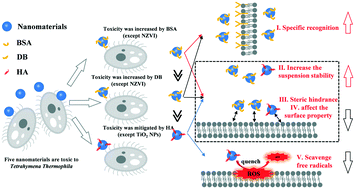当前位置:
X-MOL 学术
›
Environ. Sci.: Nano
›
论文详情
Our official English website, www.x-mol.net, welcomes your
feedback! (Note: you will need to create a separate account there.)
Factors determining the toxicity of engineered nanomaterials to Tetrahymena thermophila in freshwater: the critical role of organic matter
Environmental Science: Nano ( IF 5.8 ) Pub Date : 2019/12/06 , DOI: 10.1039/c9en01017c Dingyuan Liang 1, 2, 3, 4 , Xiangrui Wang 1, 2, 3, 4 , Shu Liu 1, 2, 3, 4 , Ying Zhu 1, 2, 3, 4 , Ying Wang 1, 2, 3, 4 , Wenhong Fan 1, 2, 3, 4, 5 , Zhaomin Dong 1, 2, 3, 4
Environmental Science: Nano ( IF 5.8 ) Pub Date : 2019/12/06 , DOI: 10.1039/c9en01017c Dingyuan Liang 1, 2, 3, 4 , Xiangrui Wang 1, 2, 3, 4 , Shu Liu 1, 2, 3, 4 , Ying Zhu 1, 2, 3, 4 , Ying Wang 1, 2, 3, 4 , Wenhong Fan 1, 2, 3, 4, 5 , Zhaomin Dong 1, 2, 3, 4
Affiliation

|
The environmental behavior and toxicity of nanomaterials can be significantly affected by the ubiquitous natural organic matter (NOM) of aquatic environments. However, general mechanisms governing the effects of different organic matter samples on nanomaterials remain elusive at present. Thus, the environmental behavior and toxicity of organic matter with different components or conformation, such as humic acid (HA), bovine serum albumin (BSA) and denatured BSA (DB), on five nanomaterials (i.e., Ag nanoparticles (NPs), polystyrene nanoparticles (PS NPs), TiO2 NPs, nano-zerovalent iron (NZVI), and multiwall carbon nanotubes (MWCNTs)) to Tetrahymena thermophila (T. thermophila) were studied. BSA and DB were found to significantly increase (up to 99%) the bioaccumulation of nanomaterials (Ag NPs and PS NPs) in T. thermophila by specific recognition. This increase was lower in DB-coated nanomaterials, compared to BSA-coated nanomaterials, revealing the importance of protein conformation in the specific recognition process. The toxicity results revealed that different organic matter samples mostly affected Ag NPs and NZVI (toxicity by dissolved metal ions) by altering their biological uptake. In the case of nanomaterials whose toxicity was dominated by suspended particles, the organic matter could alter the toxicity of these materials by changing their surface properties and their state in environmental media, and by scavenging free radicals, instead of altering the bioaccumulation process. In general, the toxicity of HA-coated nanomaterials was significantly lower than those of DB- or BSA-coated nanomaterials. Our results suggest that it is essential to consider the type and characteristics of the organic matter when evaluating the toxicity of NPs, since this represents a more realistic state of exposure.
中文翻译:

决定工程纳米材料对淡水四膜膜虫的毒性的因素:有机物的关键作用
纳米材料的环境行为和毒性会受到水生环境中普遍存在的天然有机物(NOM)的影响。然而,目前控制各种有机物质样品对纳米材料影响的一般机制仍然难以捉摸。因此,环境行为和与不同的组件或构象,如腐殖酸(HA),牛血清白蛋白(BSA)和变性的BSA(DB),在五个纳米材料(有机物的毒性即,银纳米颗粒(NP),聚苯乙烯嗜热四膜虫(T. thermophila)的纳米颗粒(PS NPs),TiO 2 NPs,纳米零价铁(NZVI)和多壁碳纳米管(MWCNTs)))进行了研究。发现BSA和DB会显着提高(高达99%)嗜热衣原体中纳米材料(Ag NPs和PS NPs)的生物积累通过特定的认可。与BSA涂覆的纳米材料相比,DB涂覆的纳米材料的这种增加较低,这揭示了蛋白质构象在特定识别过程中的重要性。毒性结果表明,不同的有机物样品主要通过改变其生物吸收来影响银纳米颗粒和NZVI(溶解金属离子的毒性)。在纳米材料的毒性主要由悬浮颗粒决定的情况下,有机物可以通过改变其表面性质和在环境介质中的状态以及清除自由基来改变这些材料的毒性,而不是改变生物蓄积过程。通常,HA包被的纳米材料的毒性显着低于DB或BSA包被的纳米材料的毒性。
更新日期:2020-02-13
中文翻译:

决定工程纳米材料对淡水四膜膜虫的毒性的因素:有机物的关键作用
纳米材料的环境行为和毒性会受到水生环境中普遍存在的天然有机物(NOM)的影响。然而,目前控制各种有机物质样品对纳米材料影响的一般机制仍然难以捉摸。因此,环境行为和与不同的组件或构象,如腐殖酸(HA),牛血清白蛋白(BSA)和变性的BSA(DB),在五个纳米材料(有机物的毒性即,银纳米颗粒(NP),聚苯乙烯嗜热四膜虫(T. thermophila)的纳米颗粒(PS NPs),TiO 2 NPs,纳米零价铁(NZVI)和多壁碳纳米管(MWCNTs)))进行了研究。发现BSA和DB会显着提高(高达99%)嗜热衣原体中纳米材料(Ag NPs和PS NPs)的生物积累通过特定的认可。与BSA涂覆的纳米材料相比,DB涂覆的纳米材料的这种增加较低,这揭示了蛋白质构象在特定识别过程中的重要性。毒性结果表明,不同的有机物样品主要通过改变其生物吸收来影响银纳米颗粒和NZVI(溶解金属离子的毒性)。在纳米材料的毒性主要由悬浮颗粒决定的情况下,有机物可以通过改变其表面性质和在环境介质中的状态以及清除自由基来改变这些材料的毒性,而不是改变生物蓄积过程。通常,HA包被的纳米材料的毒性显着低于DB或BSA包被的纳米材料的毒性。











































 京公网安备 11010802027423号
京公网安备 11010802027423号